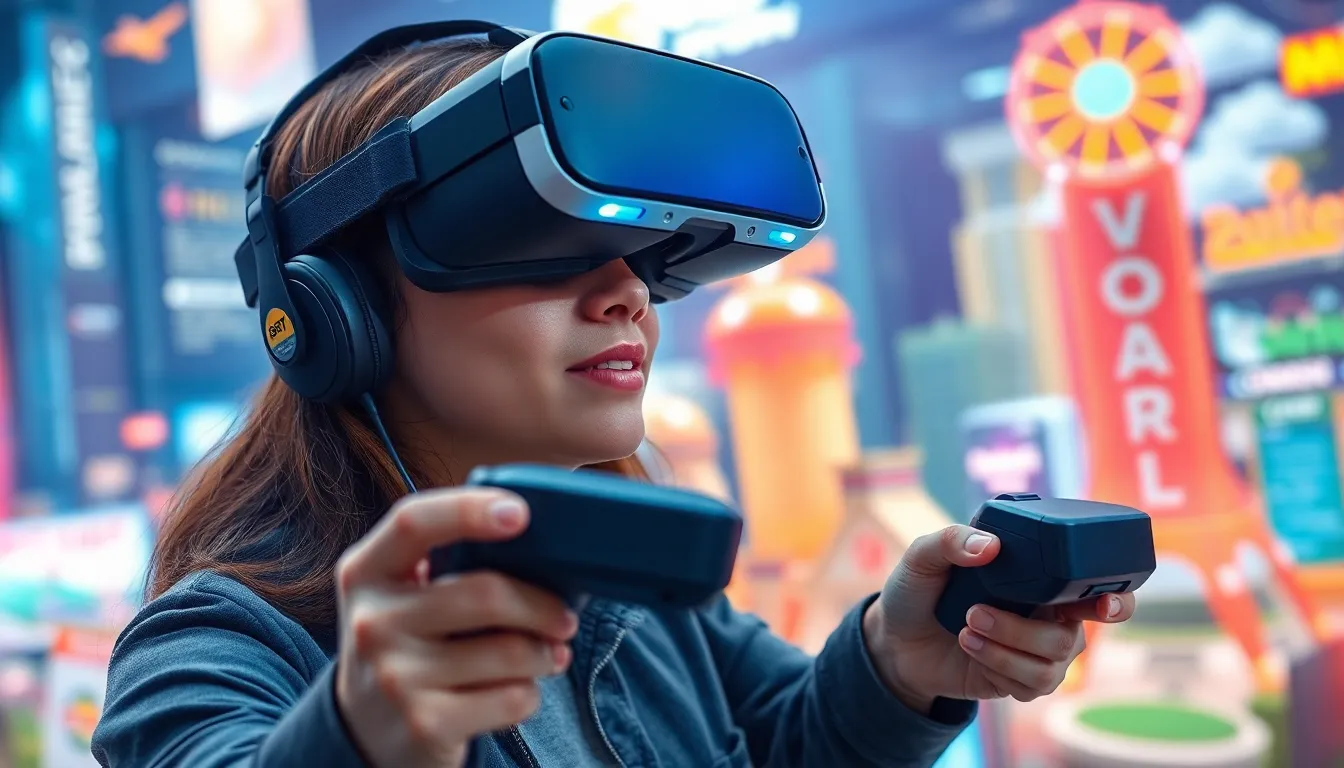Imagine stepping into a world where your wildest gaming dreams come alive. A virtual reality game system does just that, whisking players away from their living rooms to fantastical realms filled with adventure. Whether it’s battling dragons or racing futuristic cars, VR puts you right in the action, making you the hero of your own story.
Table of Contents
ToggleOverview Of Virtual Reality Game Systems
Virtual reality game systems immerse players in vivid digital environments. Standalone headsets, such as the Meta Quest 2, provide convenience without the need for external devices. PC-based systems, like the HTC Vive and Valve Index, deliver high-end graphics and enhanced performance, requiring powerful computers. Console-compatible headsets, including the PlayStation VR, integrate VR gameplay with popular gaming consoles.
These systems typically feature motion tracking technology, enabling players to interact with virtual worlds seamlessly. Sensors, cameras, and external hardware track movements and translate them into the game. Sound design also plays a crucial role, as spatial audio techniques enhance the realism of immersive experiences.
Content variety exists across platforms, with genres ranging from action and adventure to puzzles and simulations. Popular titles include “Beat Saber,” a rhythm game, and “Half-Life: Alyx,” a narrative-driven shooter. Many developers continue to push boundaries, constantly exploring innovative gameplay mechanics and storytelling methods.
Affordability varies significantly among VR systems. Entry-level headsets start around $200, while advanced setups can exceed $1000. Users must consider their budget, desired experience, and space requirements when selecting a system.
In terms of accessibility, VR technology is evolving. Developers focus on reducing motion sickness and improving comfort during extended use. Enhanced user interfaces and customizable settings make VR suitable for various players, regardless of experience level.
Overall, virtual reality game systems transform gaming landscapes, creating opportunities for immersive entertainment that engage players in unprecedented ways. The ongoing evolution of technology promises even richer experiences in the near future.
Key Features To Consider

Virtual reality game systems exhibit various key features that significantly enhance user experience. Graphics and sound quality play crucial roles in creating immersive environments for players.
Graphics and Sound Quality
Vivid graphics contribute to the realism of virtual worlds. High-resolution displays can exceed 1200 x 1080 pixels per eye, offering clarity that pulls players deeper into the action. Sound quality complements visuals, with spatial audio providing directional cues that enhance engagement. Systems featuring advanced audio technologies allow players to identify sounds from different angles, increasing immersion. Games like “Half-Life: Alyx” showcase stunning graphics and realistic soundscapes, further exemplifying the importance of these elements in VR.
Motion Tracking Technology
Accurate motion tracking technology keeps experiences fluid and responsive. State-of-the-art systems utilize inside-out tracking, which requires no external sensors, while others employ external cameras for precise movements. Systems featuring 6DoF (six degrees of freedom) allow for full body movement, enabling users to duck, lean, and navigate their environments naturally. Controllers with haptic feedback enhance this capability, replicating sensations and impacts realistically. Tracking technologies can significantly reduce latency and improve overall gameplay, ensuring that movements translate seamlessly into the virtual space.
Popular Virtual Reality Game Systems
Several virtual reality game systems capture players’ attention, offering diverse gaming experiences. These systems vary in design, performance, and content available, allowing gamers to select based on their preferences.
Oculus Quest 2
Oculus Quest 2 stands out as a leading standalone headset. This device operates without a PC or console, providing flexibility and ease of use. It features a high-resolution display of 1832 x 1920 pixels per eye, delivering stunning visuals. Users enjoy access to a robust library of titles, including popular games like “Beat Saber” and “Resident Evil 4 VR.” The Touch controllers enhance immersion by accurately tracking movements. With a price point starting around $299, it appeals to those seeking an affordable entry into VR gaming. Additionally, its wireless design eliminates cumbersome cables, promoting a seamless gaming experience.
PlayStation VR
PlayStation VR integrates seamlessly with PlayStation consoles, enhancing gaming for dedicated fans. This system features a 1080p display, providing clear and engaging visuals. Games like “Astro Bot Rescue Mission” and “Blood and Truth” showcase its capabilities, offering unique gameplay experiences. Compatibility with PlayStation Camera and Move controllers enhances the immersive experience. Priced around $399, it remains competitively positioned in the market. Its integration with existing PlayStation ecosystems makes it a popular choice among console gamers. A range of exclusive titles continues to attract interest, ensuring fresh content for users.
Benefits Of Using Virtual Reality Game Systems
Virtual reality game systems offer significant advantages that enhance gaming experiences. These benefits range from heightened immersion to unique social interaction opportunities.
Enhanced Immersion
Immersion levels achieve new heights with virtual reality systems. Players feel as if they exist within the game world rather than merely observing it. Vivid graphics and spatial audio create a more engaging environment, making challenges feel realistic. Environments often change in response to player actions, further deepening engagement. Experiences like navigating through a fantasy realm or strategizing in futuristic battlegrounds foster a genuine sense of presence. The innovative use of motion tracking technology enables natural movements, translating gestures directly into gameplay. These elements combine to deliver a compelling escape from reality, captivating players as they explore rich, dynamic virtual landscapes.
Social Interaction Opportunities
Social aspects of virtual reality gaming redefine player interactions. Participants can engage with friends and strangers alike in shared virtual spaces. Multiplayer experiences promote teamwork and competition in unique settings, providing heightened enjoyment. Many VR platforms include voice chat features, allowing players to communicate easily during gameplay. Their ability to meet virtually fosters connections across geographical boundaries. Strategies often develop as players collaborate on missions or navigate challenges together. This sense of community enhances motivation and enjoyment, making VR gaming a platform for both socializing and entertainment. As technology evolves, social features in virtual reality continue to expand, enriching player interactions and experiences further.
Challenges And Limitations
Virtual reality gaming encounters several challenges and limitations that users must consider.
Cost Considerations
Affordability significantly influences VR adoption. Entry-level headsets are available for around $200, while high-end setups may exceed $1000. This range creates varying barriers for new users looking to enter the VR space. Ongoing expenses can arise from additional accessories, subscriptions, and the need for powerful gaming PCs, which can add hundreds to thousands in costs. Pricing strategies vary among manufacturers, necessitating careful comparison to find the best fit. Shoppers should weigh features against budgetary constraints to ensure a satisfying investment.
Space Requirements
Space requirements present another hurdle for VR gamers. Many systems demand a dedicated physical area to move safely and effectively. Clearances of at least 6.5 feet by 6.5 feet are often recommended for optimal tracking and an enjoyable experience. Without sufficient space, players may encounter obstacles or injuries while engaging with the VR environment. Standalone headsets reduce some spatial needs, as they do not rely on external sensors, but gameplay might feel limited in smaller areas. Users should assess their available space before committing to a system to maximize their VR enjoyment.
Virtual reality game systems are reshaping how players engage with digital worlds. The blend of immersive graphics and advanced audio creates experiences that feel incredibly real. As technology continues to evolve, the potential for even deeper interaction and more varied content expands.
Affordability and accessibility remain crucial factors as developers work to make VR gaming available to a broader audience. With options ranging from standalone headsets to high-end setups, there’s something for every budget and preference.
As gamers embrace this innovative medium, the future of virtual reality holds exciting possibilities. From thrilling adventures to unique social experiences, VR gaming is set to captivate and inspire players for years to come.




